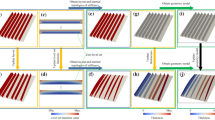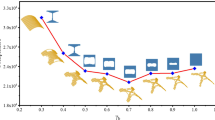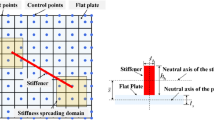Abstract
Stiffened plates are widely used in aerospace structures as load-bearing components. In order to obtain a novel design of stiffened structures with excellent performance, a generative design method of stiffened plates (GDMSP) based on the homogenization method is proposed in this paper, which optimizes the stiffener layout based on an equivalent model. Then, the detailed model can then be obtained by extracting the stiffener path from the discrete distribution of stiffener angles. Moreover, the optimized design can be obtained by size optimization based on the detailed model. Two examples are used to illustrate the proposed framework, including the stiffness maximization of a rectangle stiffener plate and the buckling load maximization of a square stiffener plate. The optimized stiffener configurations are characterized by streamlines and uniform lines, respectively. For the first example, the stiffness of the stiffener design has an improvement of 17%. For the second example, the optimized design improves the buckling load by 35%. Results indicate that the proposed method can effectively provide a novel generative design for stiffened plates. Moreover, the obtained results have a clear stiffener path and have a noticeable improvement in performance, which can be directly used to establish a detailed model.















Similar content being viewed by others
References
Aage N, Andreassen E, Lazarov BS, Sigmund O (2017) Giga-voxel computational morphogenesis for structural design. Nature 550:84
Ansola R, Canales J, Tárrago JA, Rasmussen J (2002) An integrated approach for shape and topology optimization of shell structures. Comput Struct 80:449–458. https://doi.org/10.1016/S0045-7949(02)00019-6
Bojczuk D, Szteleblak W (2008) Optimization of layout and shape of stiffeners in 2D structures. Comput Struct 86:1436–1446
Bruyneel M (2011) SFP–a new parameterization based on shape functions for optimal material selection: application to conventional composite plies. Struct Multidisc Optim 43:17–27
Bushnell D (1993) Optimization of composite, stiffened, imperfect panels under combined loads for service in the postbuckling regime. Comput Methods Appl Mech Eng 103:43–114. https://doi.org/10.1016/0045-7825(93)90041-U
Cai Y, Xu L, Cheng G (2014) Novel numerical implementation of asymptotic homogenization method for periodic plate structures. Int J Solids Struct 51:284–292
Cheng K-T, Olhoff N (1981) An investigation concerning optimal design of solid elastic plates. Int J Solids Struct 17:305–323
Cheng G, Cai Y, Xu L (2013) Novel implementation of homogenization method to predict effective properties of periodic materials. Acta Mech Sin 29:550–556
Chung J, Lee K (1997) Optimal design of rib structures using the topology optimization technique. Proc Inst Mech Eng -- Part C 211:425–437
Ding X, Yamazaki K (2004) Stiffener layout design for plate structures by growing and branching tree model (application to vibration-proof design). Struct Multidisc Optim 26:99–110
Gao T, Zhang W, Pierre D (2012) A bi-value coding parameterization scheme for the discrete optimal orientation design of the composite laminate. Int J Numer Methods Eng 91(1):98–114
Gersborg AR, Andreasen CS (2011) An explicit parameterization for casting constraints in gradient driven topology optimization. Struct Multidisc Optim 44:875–881
Hao P, Wang B, Li G (2012) Surrogate-based optimum design for stiffened shells with adaptive sampling. AIAA J 50:2389–2407
Hao P, Wang B, Tian K, Li G, Du K, Niu F (2016) Efficient optimization of cylindrical stiffened shells with reinforced cutouts by curvilinear stiffeners. AIAA J 54:1–14
Hao P, Liu DC, Zhang KP, Yuan Y, Wang B, Li G, Zhang X (2021) Intelligent layout design of curvilinearly stiffened panels via deep learning-based method. Mater Des 197:109180
Hirschler T, Bouclier R, Duval A, Elguedj T, Morlier J (2019) The embedded isogeometric Kirchhoff-Love shell: from design to shape optimization of non-conforming stiffened multipatch structures. Comput Methods Appl Mech Eng 349:774–797
Hu T, Ding X, Shen L, Zhang H (2020) Improved adaptive growth method of stiffeners for three-dimensional box structures with respect to natural frequencies. Comput Struct 239:106330. https://doi.org/10.1016/j.compstruc.2020.106330
Jármai K, Snyman JA, Farkas J (2006) Minimum cost design of a welded orthogonally stiffened cylindrical shell. Comput Struct 84:787–797
Ji J, Ding X, Xiong M (2014) Optimal stiffener layout of plate/shell structures by bionic growth method. Comput Struct 135:88–99. https://doi.org/10.1016/j.compstruc.2014.01.022
Kegl M, Brank B (2006) Shape optimization of truss-stiffened shell structures with variable thickness. Comput Methods Appl Mech Eng 195:2611–2634. https://doi.org/10.1016/j.cma.2005.05.020
Lam YC, Santhikumar S (2003) Automated rib location and optimization for plate structures. Struct Multidisc Optim 25:35–45. https://doi.org/10.1007/s00158-002-0270-7
Lazarov BS, Wang F (2017) Maximum length scale in density based topology optimization. Comput Methods Appl Mech Eng 318:826–844
Liu Y, Shimoda M (2015) Non-parametric shape optimization method for natural vibration design of stiffened shells. Comput Struct 146:20–31
Liu S, Li Q, Chen W, Hu R, Tong L (2015) H-DGTP—a Heaviside-function based directional growth topology parameterization for design optimization of stiffener layout and height of thin-walled structures. Struct Multidisc Optim 52:903–913
Liu H, Li B, Yang Z, Hong J (2017) Topology optimization of stiffened plate/shell structures based on adaptive morphogenesis algorithm. J Manuf Syst 43:375–384. https://doi.org/10.1016/j.jmsy.2017.02.002
Liu D, Hao P, Zhang K, Tian K, Wang B, Li G, Xu W (2020) On the integrated design of curvilinearly grid-stiffened panel with non-uniform distribution and variable stiffener profile. Mater Des 190:108556
Lund E (2009) Buckling topology optimization of laminated multi-material composite shell structures. Steel Constr 91:158–167
Lund E, Stegmann J (2010) On structural optimization of composite shell structures using a discrete constitutive parametrization. Wind Energy 8:109–124
Oberndorfer JM, Achtziger W, Hörnlein HREM (1996) Two approaches for truss topology optimization: a comparison for practical use. Struct Optim 11:137–144
Schittkowski K (1986) NLPQL: A FORTRAN subroutine for solving constrained nonlinear programming problems. Ann Oper Res 5:485–500
Slemp WCH, Bird RK, Kapania RK, Havens D, Norris A, Olliffe R (2011) Design, optimization, and evaluation of integrally stiffened Al-7050 panel with curved stiffeners. J Aircr 48:1163–1175
Miki Man & Cybernetics Conference Smc MBT-IS (1999) A parallel genetic algorithm with distributed environment scheme
ABAQUS Standard User's Manual Version 6.10[M] (2010) Pawtucket: Karlsson and Sorensen Inc.
Stegmann J, Lund E (2005) Discrete material optimization of general composite shell structures. Int J Numer Methods Eng 62:2009–2027
Sun Z, Cui R, Cui T, Liu C, Shi S, Guo X (2020) An optimization approach for stiffener layout of composite stiffened panels based on moving morphable components (MMCs). Acta Mech Solida Sin 33:650–662
Svanberg K (2010) The method of moving asymptotes—a new method for structural optimization. Int J Numer Methods Eng 24:359–373
Wang B, Hao P, Li G, Wang XJ, Tang XH, Luan Y (2014) Generatrix shape optimization of stiffened shells for low imperfection sensitivity. Science China 57:2012–2019
Wang B, Tian K, Zhou C, Hao P, Zheng Y, Ma Y, Wang J (2017) Grid-pattern optimization framework of novel hierarchical stiffened shells allowing for imperfection sensitivity. Aerosp Sci Technol 62:114–121
Wang D, Abdalla MM, Zhang W (2018) Sensitivity analysis for optimization design of non-uniform curved grid-stiffened composite (NCGC) structures. Compos Struct 193:224–236
Wang D, Abdalla MM, Wang Z-P, Su Z (2019) Streamline stiffener path optimization (SSPO) for embedded stiffener layout design of non-uniform curved grid-stiffened composite (NCGC) structures. Comput Methods Appl Mech Eng 344:1021–1050
Wang D, Yeo S-Y, Su Z, Wang Z-P, Abdalla MM (2020) Data-driven streamline stiffener path optimization (SSPO) for sparse stiffener layout design of non-uniform curved grid-stiffened composite (NCGC) structures. Comput Methods Appl Mech Eng 365:113001
Wang B, Zhou Y, Tian K, Wang G (2020) Novel implementation of extrusion constraint in topology optimization by Helmholtz-type anisotropic filter. Struct Multidisc Optim 62:2091–2100
Yan J, Cheng G, Liu L (2008) A Uniform Optimum Material Based Model for Concurrent Optimization of Thermoelastic Structures and Materials. Int J Simul Multidisci Des Optim 2:259–266
Yan J, Duan Z, Lund E, Wang J (2017) Concurrent multi-scale design optimization of composite frames with manufacturing constraints. Struct Multidisc Optim 56:519–533. https://doi.org/10.1007/s00158-017-1750-0
Zhang S, Norato JA (2017) Optimal design of panel reinforcements with ribs made of plates. J Mech Des. https://doi.org/10.1115/1.4036999
Zhang S, Norato JA, Gain AL, Lyu N (2016) A geometry projection method for the topology optimization of plate structures. Struct Multidisc Optim 54:1173–1190. https://doi.org/10.1007/s00158-016-1466-6
Zhang S, Gain AL, Norato JA (2020) Adaptive mesh refinement for topology optimization with discrete geometric components. Comput Methods Appl Mech Eng 364:112930. https://doi.org/10.1016/j.cma.2020.112930
Zhao W, Kapania RK (2016) Buckling analysis of unitized curvilinearly stiffened composite panels. Compos Struct 135:365–382
Zhou Y, Tian K, Xu S, Wang B (2020) Two-scale buckling topology optimization for grid-stiffened cylindrical shells. Thin-Walled Struct 151:106725. https://doi.org/10.1016/j.tws.2020.106725
Zhou M, Fleury R, Shyy Y-K, Thomas H, Brennan J (2002) Progress in topology optimization with manufacturing constraints. 9th AIAA/ISSMO symposium multidisciplinary analysis optimization. American Institute of Aeronautics and Astronautics
Zhu J-H, Gu X-J, Zhang W-H, Beckers P (2013) Structural design of aircraft skin stretch-forming die using topology optimization. J Comput Appl Math 246:278–288
Acknowledgements
This study was funded by the National Natural Science Foundation of China (11772078 and 11825202), the Project supported by Liaoning Provincial Natural Science Foundation (2019-YQ-01), and Liaoning Revitalization Talents Program (XLYC1907142 and XLYC1802020). Moreover, the authors gratefully acknowledge financial support from the China Scholarship Council.
Author information
Authors and Affiliations
Corresponding author
Ethics declarations
Conflict of interest
The authors declare that they have no conflict of interest.
Replication of results
All the key formulas for the calculation have been provided in the article. If the reader is interested, we can provide the Matlab code.
Additional information
Responsible Editor: Graeme James Kennedy
Publisher's Note
Springer Nature remains neutral with regard to jurisdictional claims in published maps and institutional affiliations.
Appendix: The sensitivity analysis of the linear buckling load
Appendix: The sensitivity analysis of the linear buckling load
In this paper, the linear buckling load is calculated with the finite element method by solving the eigenvalue equation as follows.
For the DMO, the sensitivities are necessary. The sensitivities are calculated with the adjoint method, which is briefly derived as follows. The direct approach to obtain the eigenvalue sensitivity in case of a distinct, i.e., the simple eigenvalue \(\lambda_{j}\) is to differentiate Eq. (22) to the design variable \(x_{ij}\) premultiply by \({{\varvec{\Phi}}}_{j}^{T}\) and make use of Eq. (22). Then the following expression can be obtained as
where it has been assumed that the eigenvectors have been \({\mathbf{K}}_{{{\varvec{\upsigma}}}}\) -orthonormalized, such that \({{\varvec{\Phi}}}_{i}^{T} {\mathbf{K}}_{{{\varvec{\upsigma}}}} {{\varvec{\Phi}}}_{i} = 1\). The geometric matrix is an implicit function of the displacement field, i.e., \({\mathbf{K}}_{{{\varvec{\upsigma}}}} = {\mathbf{K}}_{{{\varvec{\upsigma}}}} \left( {{\mathbf{u}}({\mathbf{x),x}}} \right)\), which has to be taken into account as
Then the static equilibrium equation \({\mathbf{K}}{\mathbf{u}}{\mathbf{ = F}}\) is differentiated to the design variable \(x_{ij}\) as
where the load sensitivity \(\partial {\mathbf{F}}/\partial x_{ij}\) is zeros. Then, substituting Eq. (25) into Eq. (24) yields
Thus, the adjoint vector \({{\varvec{\Lambda}}}\) that satisfies Eq. (27) can be introduced.
Finally, substituting the adjoint vector \({{\varvec{\Lambda}}}\) into Eq. (23), the full analytically design sensitivities can be obtained as follows:
Rights and permissions
About this article
Cite this article
Ma, X., Wang, F., Aage, N. et al. Generative design of stiffened plates based on homogenization method. Struct Multidisc Optim 64, 3951–3969 (2021). https://doi.org/10.1007/s00158-021-03070-3
Received:
Revised:
Accepted:
Published:
Issue Date:
DOI: https://doi.org/10.1007/s00158-021-03070-3




